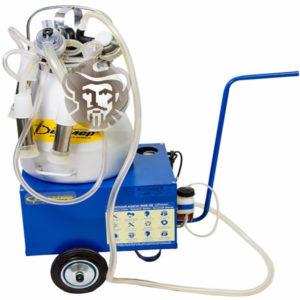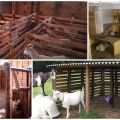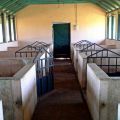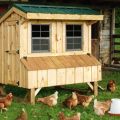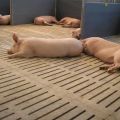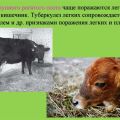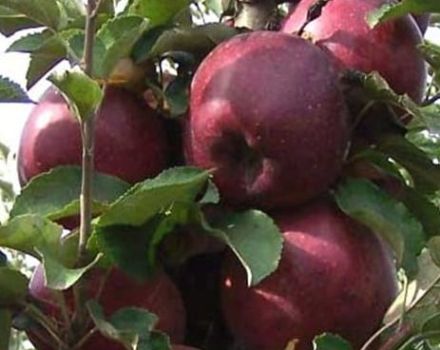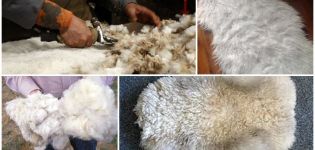Drawing up a project and a plan for a cowshed for 20 heads, how to build it yourself
Building a small farm like a 20 head cowshed will require a lot of planning. A competent approach to design at the initial stage of construction, the creation of optimal conditions for keeping cattle is the main thing that is important to focus on during construction. You should also take into account the climate in the region, fulfill the necessary hygiene and sanitary standards. This affects both the health and productivity of the cows.
Project and drawings
Before starting the construction of the barn, a clear construction plan will be required. A facility for 20 head of cattle is considered a small farm, but it will also require a plan and a detailed design. In such a building, animals can be arranged in 1-2 rows, which will facilitate maintenance.
First of all, you will need to calculate the area. In this case, a number of parameters are taken into account:
- for each cow you need from 6 to 9 m3;
- one calf will need up to 4.5 m3 when kept in a pen and 1.5 m3 in a separate stall;
- for one bull in the herd, a separate stall 1.5 m3 wide, with a total area of 9 m3 is needed.
The project should take into account the availability of the necessary ancillary and auxiliary premises: a small warehouse for feed and inventory, rooms for service personnel, an isolator for sick individuals and a separate area for dairy products. You will need to calculate the area of the barn, the height of the walls, the level of mechanization, ventilation system, lighting, think over a method of heating and supplying water to the premises.
Plan of the barn for 20 heads:
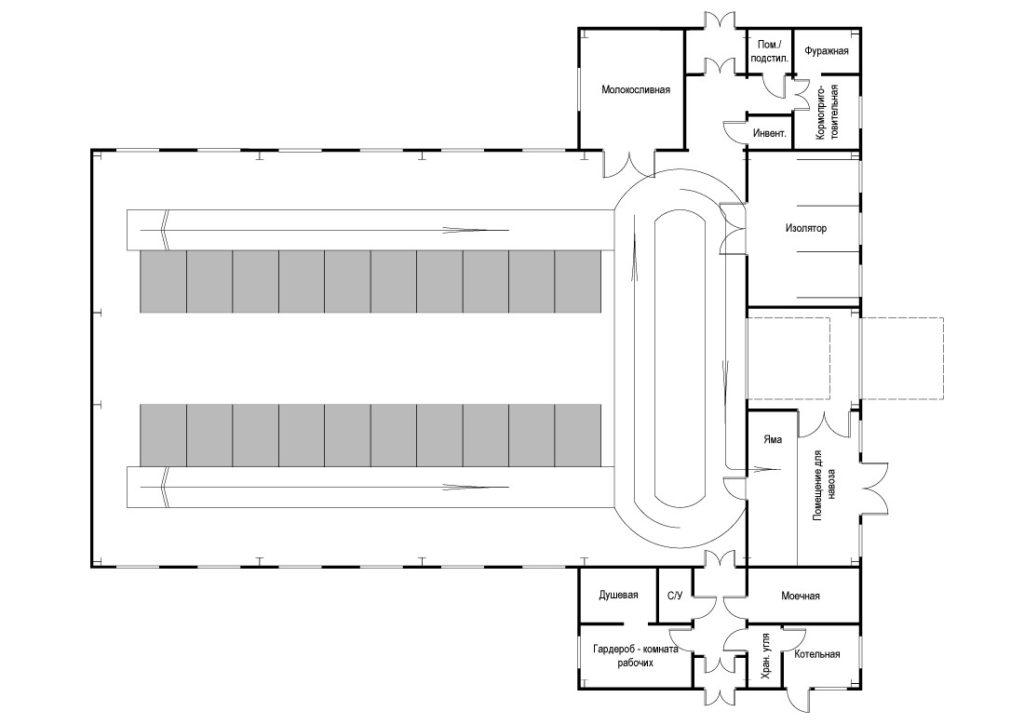
The design takes place as follows. The customer forms a technical assignment, in which he introduces his wishes. The designer gets acquainted with it and correlates it with the norms and requirements of the governing bodies. Then the project is tied to the building site, materials are selected and an estimate is formed.
Requirements for the place of detention
Small farms that can accommodate 20 to 100 head of cattle, with proper management, can bring a stable income. But at the planning and design stage, you need to know the basic principles of building mini-farms, barns and sheds.
Before starting construction, it is important to consider a number of rules:
- the farm should not be located in the immediate vicinity of residential buildings and water sources;
- materials for construction are chosen of high quality, safe, with good thermal insulation properties;
- the size of the farm must meet the needs of the animals;
- the territory of the cowshed, utility rooms, sheds and the walking area must be fenced in to protect the cows from the penetration of wild animals;
- for cattle, daily exercise is needed, therefore, it is necessary to make an arena or a walking area;
- it is advisable to arrange the stalls in two rows and equip each with a drinker, a feeder, a drain for waste.
An example of a small barn:

When choosing a site for the construction of a stationary facility for cattle, one must take into account the location of groundwater. They should be located no closer than 5 m from the construction site. Highways and railways (at least 300 m), country roads (50 m) should be located at a considerable distance from the future cattle farm.
Zoohygienic requirements provide for the construction of a farm for cows on a small hill, on the leeward side, since possible infectious agents, odors should not spread to the nearest settlements.
It is necessary to equip the barn with convenient access roads for the delivery of feed, equipment, as well as for the removal of waste and dairy products.
Required tools and materials
Building a barn will require a specific set of tools and materials. The minimum set of construction tools for the construction of a cattle facility is as follows:
- concrete mixer;
- electric drill;
- laser tape measure;
- chainsaw;
- ax, hammer, chisel;
- hacksaw, chisel;
- shovel;
- level.
From the materials you need to purchase:
- concrete for the foundation;
- crushed stone;
- covering material for the roof;
- floor boards;
- material for the construction of walls;
- paints and varnishes;
- facing tiles for utility rooms and rooms for dairy products;
- waterproofing coating, for example, roofing material.
The place for exercise must be securely fenced off:

Wall materials are of great importance in the construction of a barn. They must have thermal insulation properties. In the southern regions of our country, farmers do without a heating system, using insulated walls and floors.
How to build a barn for 20 heads with your own hands
After careful calculations, competent planning, preparation of estimates, you can start construction. Adhering to all the necessary rules and regulations, having the necessary skills in construction, it is quite possible to build a barn yourself.
Foundation
The most profitable from an economic point of view, as well as functional, will be a concrete foundation. It will allow in the future to erect wooden walls or foam concrete. Since the foundation is the foundation of the room, it must be as reliable as possible and have a long service life. If the project for keeping cattle is long-term, then it is not recommended to make the base for the premises wooden or columnar.
Floor and gutter
Floors should be solid or slatted with a slight slope. Basic requirements for the floor material: good thermal conductivity, resistance to detergents. The best are floors with rubber-cord flooring, as well as expanded clay-bitumen and ground-cement.
Stable floors should be soft:

Soft bedding should be provided as hard floors are detrimental to cow health. In addition, they must have a slope for draining the liquid into the manure channels.
Walls
Wooden materials have shown themselves well in terms of thermal conductivity. However, they have a minus - fragility. Brick barns are often erected, which are also beneficial in a number of parameters.But in a harsh climate in a number of regions, it is necessary to make a two-layer structure, and lay insulation between the layers. Recently, foam blocks, sandwich panels and adobe have gained popularity. These materials are easy to assemble, durable and inexpensive. A plus is their ability to maintain the temperature level in the room.
Saman is a building material, a brick made from a mixture of clay, straw and some water. Today the composition of adobe can include sand, cement, crushed stone or lime. Sometimes complex synthetic components are added, based on the purpose of the room.
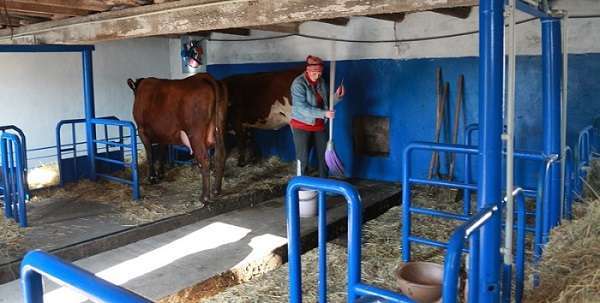
Roof
A pitched or gable roof is often used. As a covering material, corrugated board, roofing felt, slate are used. Profiled sheeting is more preferable, since the roof is made at an angle, which does not allow snow to accumulate. It is advisable to make an attic - this is a place for storing hay and additional insulation.
Windows and doors
Doors and windows made of high-quality, but inexpensive material are suitable for a barn for 20 heads. It is important that they are easy to clean and decontaminate. They can be installed in any convenient place at the discretion of the customer.
Ventilation
Barn ventilation system:

One of the simplest ventilation schemes is to install a chimney on the roof of the barn. It is often made from planks. Fresh air from the street enters through the windows, and the exhaust air is discharged through the hood.
Communications
A pumping station or pump is required to supply water to the stable. In this case, it is better to use the ground option. A hose must be drawn from the water source, securely wrapped with insulation and buried under the ground.
As for the sewage system, at the time of planning, you need to take into account the presence of drains and floors located at an angle. With their help, it will be easier to remove manure from the barn.

